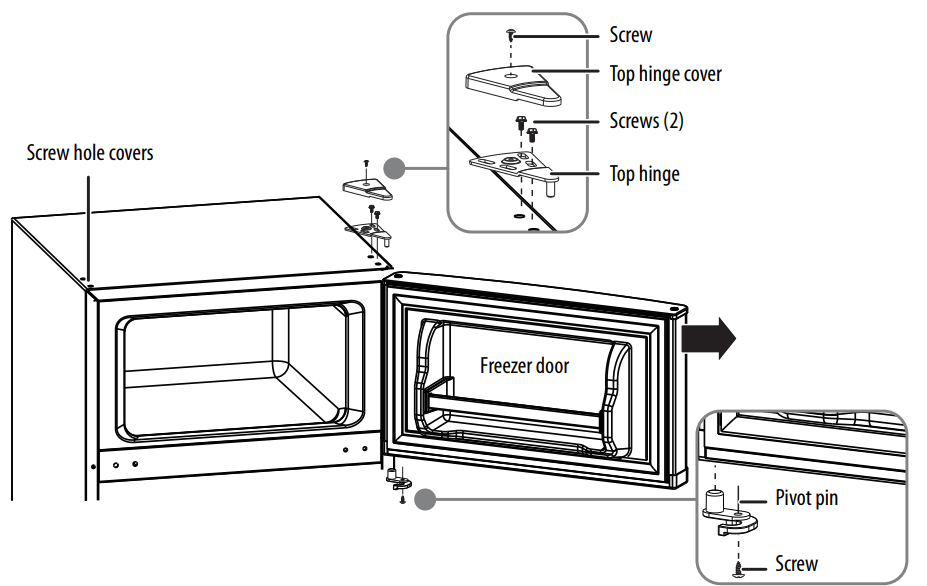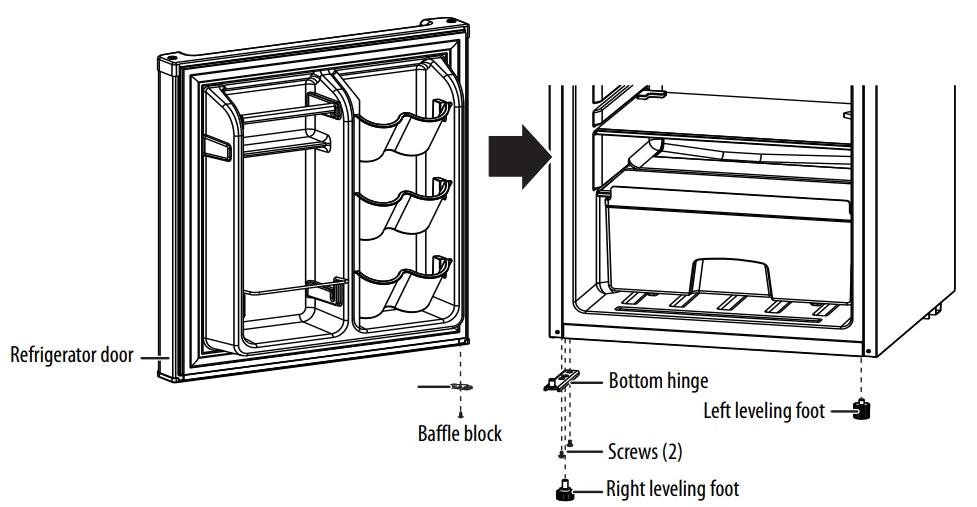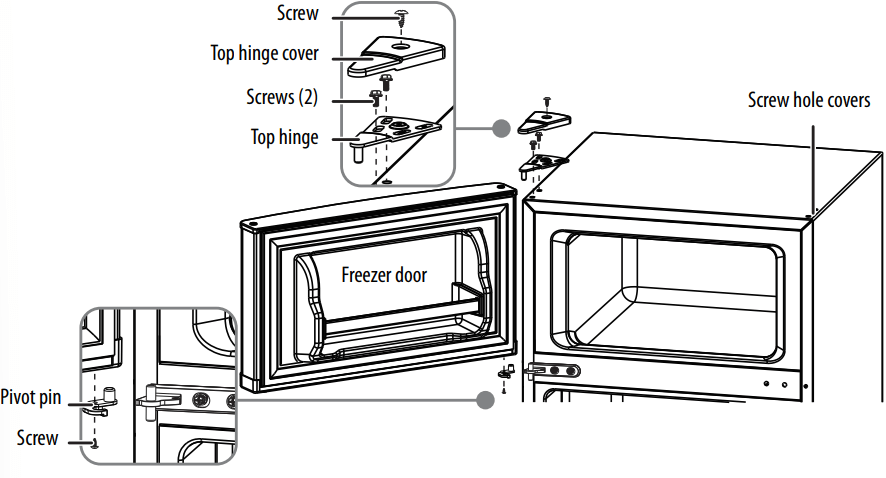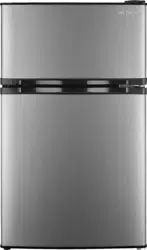Documents: Go to download!
User Manual
- User Manual - (English)
- User Guide - (French)
- User Guide - (Spanish)
- Warranty - (English)
- FEATURES
- OPERATION
- MAINTENANCE AND CLEANING
- TROUBLESHOOTING
Table of contents
User Guide Mini Fridge
FEATURES
Package contents
• 2-door compact refrigerator
• Adjustable shelves
• Ice cube tray
• Defrost shovel
• User Guide
Main components
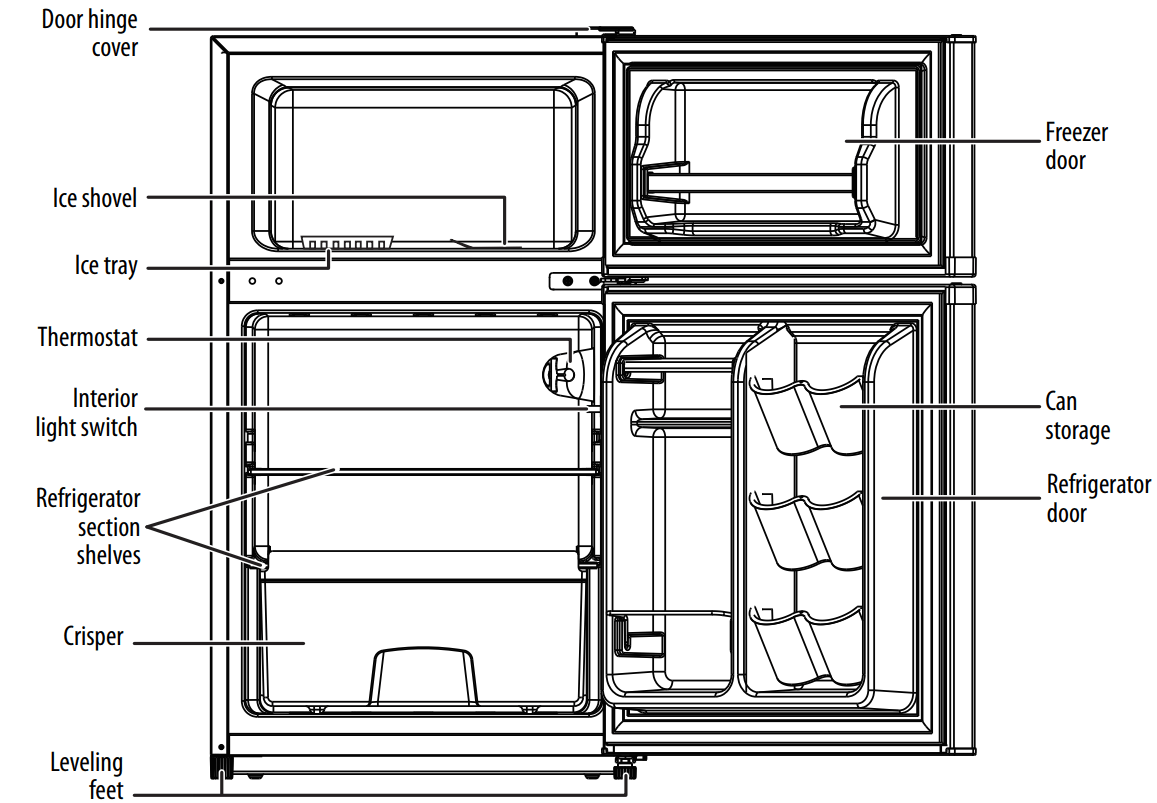
Note: To remove a refrigerator shelf, lift it up, then slide it out.
Dimensions
OPERATION
Setting the thermostat
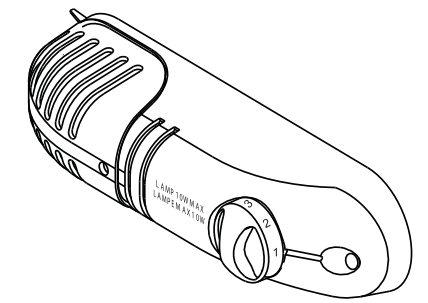
- The first time you turn the refrigerator on, adjust the thermostat to “7” and run for at least two hours before putting food in.
- After it is fully cooled, test it and adjust towards “4” to make it less cool, to best suit your needs. The “4” setting should be appropriate for home or office refrigerator use.
Notes:
- Turning the thermostat to the “0” position stops the cooling cycle but does not shut off the power to the refrigerator.
- If the refrigerator is unplugged or loses power, you must wait three to five minutes before restarting it. If you attempt to restart before this time delay, the refrigerator will not start.
- Large amounts of food will lower the cooling efficiency of the refrigerator.
- If you choose to change the thermostat setting, adjust it by one increment at a time. Allow several hours for the temperature to stabilize between adjustments.
Using the freezer compartment
Making ice
- Set the thermostat to “7”.
- Fill the ice cube tray (2/3 capacity) with cold water and place the tray on the bottom of the freezer compartment to freeze properly.
- When the water in the ice cube tray has hardened, remove the ice tray from the freezer, then twist slightly to eject the ice cubes from the tray.
- Re-set the thermostat to “4” when you are done making ice.
Defrosting your refrigerator
This refrigerator is not designed to defrost automatically. In order to prevent damage to the interior liner of the refrigerator from excessive frost build-up, defrost the refrigerator every three months or when ice or frost is approximately mm) thick inside the freezer compartment.
- Set the thermostat to “0”, then remove all contents from the freezer compartment.
- Leave the freezer door open to allow accumulated ice and frost to melt. Remove large pieces of ice as needed.
- CAUTION:
- Do not use hot water or electric heating devices to melt the accumulated ice.
- The refrigerator door must remain closed while defrosting the freezer.
- CAUTION:
- After defrosting, remove accumulated ice and water, then wipe the freezer compartment dry with a soft cloth.
- Even though ice is not visibly present in the freezer compartment, allow the evaporator, located behind the freezer wall, to completely defrost for approximately two hours (total) before restarting the refrigerator.
- Restart following the instructions in “Setting the thermostat”
Reversing the door position
CAUTION: To avoid injury to yourself or your property, we recommend that someone assist you during the door reversal process.
Before you begin
You will need: A 10 mm socket driver and a Phillips screw driver.
- Make sure that your refrigerator is unplugged and empty.
- Have someone available to assist you in the process.
- Keep all of the parts you remove to reuse them later.
- Removing the door requires that the refrigerator be tilted backwards. Rest the refrigerator on something solid, such as a chair, just below the top panel.
- Do not lay the refrigerator completely flat so that you do not damage the coolant system.
Removing the door
- Remove the screw holding the top hinge cover to the top of your refrigerator, then remove the top hinge cover.
- Remove the screws holding the top hinge to your refrigerator, then remove the hinge. Pull the freezer door upwards and remove it from the refrigerator.
- Remove the screw hole covers from the top left side of your refrigerator. Keep the screw hole covers in a handy place. You need them later.
- Remove the screw holding the pivot pin on the bottom right side of the freezer door, then remove the pivot pin.
- Remove the two screws holding the middle hinge to the refrigerator body, then remove the hinge.
- Pull the refrigerator door upwards and remove it from the refrigerator.
- Tilt the refrigerator back.
- Unscrew the right and left leveling feet, then remove them.
- Remove the two screws holding the bottom hinge on the refrigerator and remove the hinge.
- Remove the baffle block from the bottom-right side of the door.
Reinstalling the doors
- Install the baffle block on the bottom-left side of the door.
- Install the leveling foot you removed from the left side into the right-bottom of your refrigerator and install the leveling foot you removed from the right side into the left bottom.
- Align the hole in the bottom left of the refrigerator door with the bottom hinge pin and install the door on the hinge pin.
- Install the bottom hinge on the left bottom of your refrigerator using the screws you previously removed. Tighten the screws.
- Place the middle hinge pin into the left top of the refrigerator door, then install the middle hinge on the left of the refrigerator with the screws your previously removed. Do not fully tighten the screws.
- Check the fit and alignment (vertical and horizontal) of the door and make sure that it opens and closes freely, then tighten the screws holding the middle hinge.
- Install the pivot pin on the bottom-left of the freezer door using the screw you previously removed.
- Align the hole on the bottom-left of the freezer door with the top pin on the middle hinge, then install the freezer door on the hinge pin.
- Place the top hinge pin into the top of the freezer door, then install the top hinge on the top left side of the refrigerator with the screws you previously removed.
- Check the fit and alignment (vertical and horizontal) of the door and make sure that it moves freely open and closed, then tighten the screws holding the top hinge.
- Install the screw hole covers you removed previously from the holes on the top left side of your refrigerator into the holes on the top right of your refrigerator.
- Adjust the leveling feet to level the refrigerator
MAINTENANCE AND CLEANING
Your refrigerator is designed for year-round use with only minimal cleaning and maintenance.
When you first receive it, wipe the case with a mild detergent and warm water, then wipe dry with a dry cloth. Do this periodically to keep your refrigerator looking new.
CAUTION: To prevent damage to the finish, do not use:
- Gasoline, benzine, thinner, or other similar solvents.
- Abrasive cleaners.
Cleaning the interior of your refrigerator
1. Turn off the refrigerator and unplug it from the wall outlet.
2. Remove all food.
3. Wash the inside with a damp, warm cloth.
Note: It is recommended that you soak your cloth in a baking soda solution before washing the interior. Mix one quart of warm water and two tablespoons of baking soda.
4. Dry the interior and exterior with a soft cloth.
Changing the interior light
CAUTION:
- All parts removed must be saved to reinstall the light bulb.
- Before removing the light bulb, unplug the refrigerator from the power supply. Failure to do so could result in electrical shock or personal injury.
- Hold the lamp cover and push toward the inside of the cabinet to remove it from the refrigerator compartment.
- Unscrew the old bulb, then install the new bulb (10W/12E).
- Re-install the lamp cover.
Turning off your refrigerator for extended periods
- Turn off the refrigerator and unplug it from the wall outlet.
- Remove all food.
- Clean the refrigerator.
- Leave the door open slightly to avoid possible formation of condensation, mold, or odor.
CAUTION: Use extreme caution with children. The refrigerator should not be accessible to child's play
Moving your refrigerator
- Turn off the refrigerator and unplug it from the wall outlet.
- Remove all food.
- Securely tape down all loose items inside of your refrigerator.
- Tape the doors shut.
Note: Make sure that your refrigerator stays in an upright position during transportation.
Tips on saving energy
- Place your refrigerator in the coolest area of the room, away from heat-producing appliances or heating ducts, and out of direct sunlight.
- Let hot foods cool before placing them in the refrigerator. Overloading the refrigerator forces the compressor to run longer. Foods that freeze too slowly may lose quality or spoil.
- Wrap foods properly and wipe containers dry before placing them in the refrigerator. This cuts down on frost build-up inside the refrigerator.
- Organize and label food to reduce door openings and extended searches
TROUBLESHOOTING
PROBLEM | SOLUTION |
| My refrigerator does not work. • Make sure that your refrigerator is securely | • Make sure that your refrigerator is securely plugged into a working outlet. • Make sure that your power source has the correct voltage. Your refrigerator’s voltage rating is on a label on the back of your refrigerator. • Check the house fuse or circuit breaker box and replace the fuse or reset the circuit breaker. |
| The refrigerator compartment has a bad odor | • Make sure that all food with a strong odor (like onions) is wrapped or stored in airtight packaging. • Certain containers and wrapping materials (such as paper, foil, or plastic) can cause odors. If you think this might be the case, try using different containers or a different brand of wrapping material. • Check for spoiled food and remove it. • Clean the inside of your refrigerator. See Maintaining your refrigerato |
The refrigerator doors do not close completely. | • Make sure that no food packages are in the way. • Make sure that the door gaskets (seals) are clean. • If the door gasket does not seal, try heating then cooling the seal. You can use an electric hair dryer to heat the seal. • Make sure that your refrigerator is level. See Leveling your refrigerator on page 8. • Make sure that the top of your refrigerator is tilted backward about 0.4" (10 mm) to 0.6" (15 mm). |
The temperature is too hot. | • You may have left the doors open too long or opened them too frequently. • Make sure that no obstacle is keeping the doors from closing correctly. • Adjust the refrigerator or freezer compartment temperature. See Setting the thermostat on page 9. • Your refrigerator may not have enough clearance from walls or the ceiling. See Providing proper ventilation. |
The temperature is too cold. | • Adjust the refrigerator or freezer compartment temperature. See Setting the thermostat |
A layer of frost occurs in one of the compartments. | • A layer of frost may occur on the compartment's interior walls if the freezer is opened frequently or kept open too long. • Make sure that the air outlets are not blocked by food. • Make sure that the doors are fully closed. • To remove the frost, see Defrosting your refrigerator. |
The refrigerator door is hard to open. | • When you open the refrigerator door, warm air rushes inside. When you close the door, the warm air rushes to the condenser which causes a vacuum. This causes the door to be hard to open for about 10 to 15 seconds after closing. • If the door is hard to open at other times, try rubbing paraffin wax or petroleum jelly along the edges of the entire gasket. Paraffin wax is used for canning and is safe for use around food. |
PROBLEM | SOLUTION |
The compressor runs for a long time or turns on and off frequently. | The compressor runs longer if: • The room temperature is high. • You just added a large amount of food. Wait for the food to freeze, then check again. • You open and close the door frequently. • The door gasket is dirty. Clean the gasket. • Your refrigerator has been disconnected for a period of time. Wait for your refrigerator to cool (about four hours) before adding food. • You have the temperature set too low. |
The light inside the refrigerator does not turn on. | • Make sure that your refrigerator is plugged into a working outlet. • If a door stays open too long, your refrigerator automatically turns off the light. • Close then open the door again. • Check to see if the light is damaged. If the light is damaged, have it replaced by a qualified service technician. |
The refrigerator makes unusual noises or vibrations. | The following sounds are normal: • Compressor running noises. • Air movement noise from the small fan motor in the freezer compartment or other compartments. • Gurgling sound similar to water boiling. • Clicking noise before the compressor starts. Other unusual noises or vibrations may occur: • If you have items on the top of your refrigerator. Remove the items. • If your refrigerator is not level. |
|
• If your refrigerator is touching walls. Move it away from the walls. • If the shelves or drawers are installed incorrectly. |
The outside of the refrigerator is hot. | Heat dissipation from the condenser may make the outside feel hot. This is normal and happens if: • The room temperature is high. • You have too much food in your refrigerator. • You open and close the doors excessively. |
Water condenses on the outside of the refrigerator. | • Condensation on the exterior surface and door seal is normal when the room humidity is high. • When you open the door, warm, moist outside air meets the cold dry air inside your refrigerator. This is normal. |
See other models: NS-UZ14XWH7 NS-46D400NA14 NS-26E340A13 NS-AC12PWH9 NS-MC60SS9
